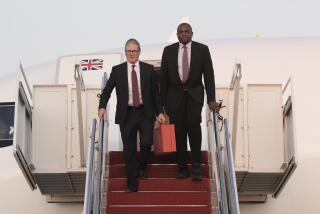U.S. May Push Missile Ban at Arms Talks : Superpowers: Bush is expected to change the U.S. position before meeting with the Soviets next week.
- Share via
WASHINGTON — After considerable argument, sentiment has built within the Administration in favor of modifying a key aspect of the U.S. position at the strategic arms reduction talks by calling for a ban on mobile land-based intercontinental missiles that carry multiple warheads, U.S. officials indicated this week.
If President Bush takes the advice, as two Administration officials suggested he would, the START negotiations, as they are known, could become more complicated. Their completion, expected this year, could be delayed.
But if accepted by the Soviets, such a ban would eliminate a 10-warhead missile system from each side. These are the Soviet SS-24s, more than a score of which are already in operation, and the U.S. program to move 50 MX missiles from silos to rail cars. Aborting the rail-garrison MX program would save about $6 billion over four years.
Bush is expected to decide the mobile missile issue and other arms control matters this weekend in preparation for a three-day visit by Soviet Foreign Minister Eduard A. Shevardnadze, beginning Wednesday, in which the remaining obstacles to a START treaty will be negotiated.
Shevardnadze and Secretary of State James A. Baker III also will discuss precise dates for the next summit of Bush and Soviet President Mikhail S. Gorbachev, expected in mid-June, as well as the wide range of political issues, including Lithuanian independence and German unification, that affect U.S.-Soviet relations.
The idea of banning mobile, multi-warhead missiles is one of the last outstanding issues in the START negotiations. Depending on how it is resolved, the two sides will then consider setting limits on the total number of warheads that can be mounted on mobile, land-based missiles.
Other issues still outstanding include the ranges of cruise missiles--both the sea- and air-launched types--below which they would not be counted under the 6,000-weapon ceiling to be set under the START treaty. Each side proposes range limits that would exclude their favored weapons but include those of the other side.
Additional limits on the very large Soviet ICBM, called the SS-18, also may be raised by U.S. negotiators following improvements in its accuracy and carrying capacity. Some U.S. officials want to reduce the ceiling of 154 SS-18s, already agreed to in START negotiations, to compensate for the missile’s improved capabilities to threaten a surprise attack.
The intra-Administration argument on the mobile, multiple-warhead missile ban has pitted Defense Secretary Dick Cheney and the military services, opponents of a ban, against top congressional Democrats and Bush’s national security adviser, Brent A. Scowcroft, who favor it.
Over the months since the issue has been debated, the major new factor has been growing realization within the Defense Department that Congress is unlikely to vote funds for the MX program in view of budget constraints and improved U.S.-Soviet relations. As a result, officials said, there is more support for the fallback position that the United States would be better off if both weapon systems are banned than if the Soviets have it while the United States does not.
Some Soviet officials have seemed sympathetic to the idea of a ban, but like U.S. officials have expressed concern that negotiating its details could postpone completion of the START treaty.
However, as congressional sentiment against the MX program has grown, the Soviets now may feel that they would be trading their existing SS-24s against an MX system that will never be built. Moscow therefore may reject the ban or propose that it be considered in subsequent negotiations on strategic arms.
In fact, the Bush Administration, like its predecessor, has proposed building two new mobile missile systems: the rail-mobile MX to equal the Soviet SS-24, and the Small ICBM (SIBCM), or Midgetman, to equal the Soviet SS-25, which also is already in operation. Both the SS-25 and the Midgetman are single-warhead systems riding on truck-like wheeled vehicles.
Sen. Sam Nunn (D-Ga.), the powerful chairman of the Senate Armed Services Committee, has warned that Congress is likely to reject both missile programs--the $6-billion MX and the $28-billion Midgetman--unless the Administration proposed to ban the MX and the SS-24. Rep. Les Aspin (D-Wis.), chairman of the House Armed Services Committee, also has expressed doubts that the Administration would get its two-missile program.
Both Nunn and Aspin favor the Midgetman over the MX, so the message from Capitol Hill in recent weeks has been that perhaps the MX mobile system could be saved by proposing to ban it and the SS-24, according to officials. Congress might show greater willingness to fund it if it appeared to be a bargaining chip to get the Soviets to give up their comparable missile system.
The argument over which land-based missiles are better is rooted in different views of how best to deter nuclear war and their respective costs.
Missiles in fixed silos are easy to target, so they might tempt an enemy to mount a surprise attack in a crisis situation. They are even more tempting if they carry multiple warheads like the MX and the SS-24, because only two attacking warheads--considered the minimum deployment against a single silo--would be needed to destroy 10 warheads on the ground.
Single-warhead missiles, in silos or on mobile platforms, are therefore better--or more stabilizing--because the attacker could only destroy one warhead at a time.
Mobile missiles, by the same logic, are more stabilizing than fixed-based missiles because they are harder to locate and therefore to destroy.
More to Read
Sign up for Essential California
The most important California stories and recommendations in your inbox every morning.
You may occasionally receive promotional content from the Los Angeles Times.













